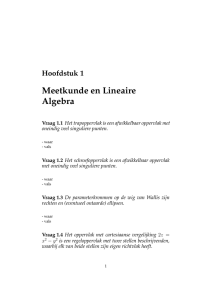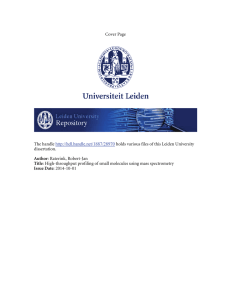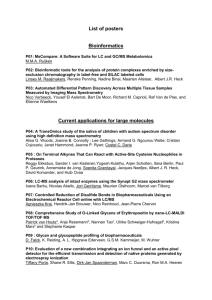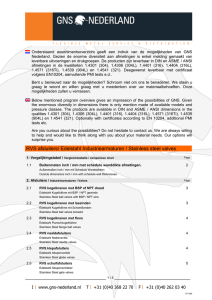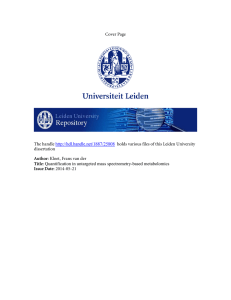Hoofdstuk 1 Meetkunde en Lineaire Algebra
advertisement
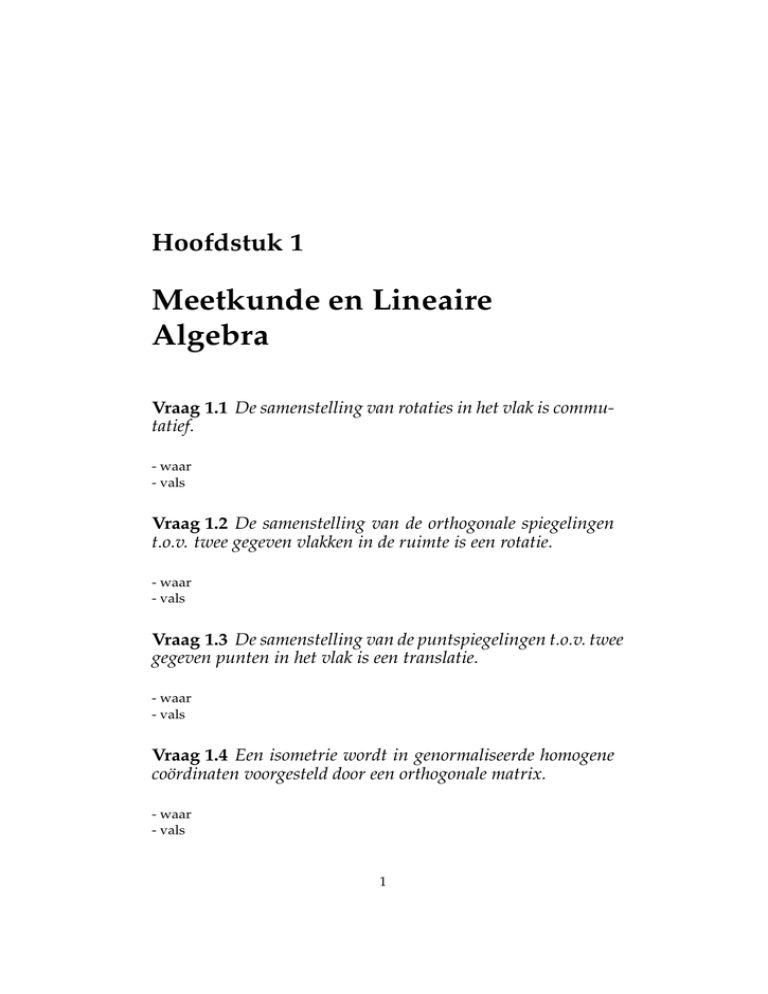
Hoofdstuk 1 Meetkunde en Lineaire Algebra Vraag 1.1 De samenstelling van rotaties in het vlak is commutatief. - waar - vals Vraag 1.2 De samenstelling van de orthogonale spiegelingen t.o.v. twee gegeven vlakken in de ruimte is een rotatie. - waar - vals Vraag 1.3 De samenstelling van de puntspiegelingen t.o.v. twee gegeven punten in het vlak is een translatie. - waar - vals Vraag 1.4 Een isometrie wordt in genormaliseerde homogene co¨ordinaten voorgesteld door een orthogonale matrix. - waar - vals 1 Vraag 1.5 Zij O de matrix geassocieerd met de orthogonale projectie op een vlak en S de matrix geassocieerd met de spiegeling t.o.v. dit vlak (telkens in genormaliseerde homogene co¨ordinaten), dan geldt er dat 2O = I + S met I de eenheidsmatrix. - waar - vals Vraag 1.6 Er bestaan oneindig veel 4 × 4 matrices A die voldoen aan de vergelijking A6 − A4 − A2 + I = 0. Hierbij stelt I de eenheidsmatrix en 0 de nulmatrix voor. - waar - vals Vraag 1.7 Er bestaan oneindig veel 3 × 3 matrices A waarvan elke natuurlijke macht opnieuw A zelf oplevert. - waar - vals Vraag 1.8 Als S een re¨ele symmetrische matrix is met S 2 = 0, dan is S = 0. - waar - vals Vraag 1.9 Zij A een re¨ele vierkante matrix, dan bestaan er steeds scalairen c ∈ C waarvoor A − cI niet inverteerbaar is. - waar - vals 2 Vraag 1.10 Als A ∈ Rn×n een nuldeler is, dan bestaat er een, op een multiplicatieve constante na unieke, matrix B ∈ Rn×n , waarvoor AB = 0. - waar - vals 3 Hoofdstuk 2 Natuurkunde I Vraag 2.1 Two boys in a canoe toss a baseball back and forth. What effect will this have on the canoe? Neglect (velocitydependent) frictional forces with water or air. - None, because the ball remains in the canoe. - The canoe will drift in the direction of the boy who throws the ball harder each time. - The canoe will drift in the direction of the boy who throws the ball with less force each time. - The canoe will oscillate back and forth always moving opposite to the ball. - The canoe will oscillate in the direction of the ball because the canoe and ball exert forces in opposite directions upon the person throwing the ball. Vraag 2.2 A 500 g firework explodes into two pieces of equal mass at an instant when it is traveling straight up at 10 m/s. If one half shoots off horizontally to the left at 20 m/s, what is the velocity, in m/s, of the other half immediately after the explosion? (The x-axis is directed right; the y-axis up.) - −20ˆı − 20ˆj - −20ˆı + 20ˆj - +20ˆı − 20ˆj - +20ˆı + 20ˆj - −20ˆı + 20kˆ Vraag 2.3 Two cylinders made of the same material roll down a plane inclined at an angle θ with the horizontal. Each travels 4 the same distance. The radius of cylinder B is twice the radius of cylinder A. In what order do they reach the bottom? - A reaches the bottom first because it has the greater acceleration. - A reaches the bottom first because it has a smaller moment of inertia. - B reaches the bottom first because is experiences a larger torque. - B reaches the bottom first because it travels a larger distance in one rotation. - They both reach the bottom at the same time, because each has the same linear acceleration. Vraag 2.4 A uniform cylinder of radius R, mass M, and length L rotates freely about a horizontal axis parallel and tangent to the cylinder, as shown below. The moment of inertia of the cylinder about this axis is - 12 M R2 - 23 M R2 - M R2 - 32 M R2 - 75 M R2 Vraag 2.5 When a wheel is rolling without slipping, the magnitude of its velocity relative to the ground is greatest at - the point in contact with the ground. - the point at the center of the wheel. - the point at the top of the wheel opposite to the point in contact with the ground. - the point farthest forward from the center of mass of the wheel. - the point farthest behind the center of mass of the wheel. 5 Vraag 2.6 A massless rope is wrapped around a uniform cylinder that has radius R and mass M, as shown in the figure. Initially, the unwrapped portion of the rope is vertical and the cylinder is horizontal. The linear acceleration of the cylinder is - (2/3)g - (1/2)g - (1/3)g - (1/6)g - (5/6)g Vraag 2.7 A thin rod of mass M and length L is struck at one end by a ball of clay of mass m, moving with speed v as shown in the figure. The ball sticks to the rod. After the collision, the angular momentum of the clay-rod system about A, the midpoint of the rod, is - (m + - (m + M L 3 )(v 2 ) M L 12 )(v 2 ) 6 - (m + - mv L2 - mvL M L 6 )(v 2 ) Vraag 2.8 A cylindrical shell rolls without slipping down an incline as shown in the figure. The linear acceleration of its center of mass is - (5/7)g sinθ - (1/2)g sinθ - (3/5)g sinθ - (2/3)g sinθ - (4/5)g sinθ Vraag 2.9 A solid sphere, spherical shell, solid cylinder and a cylindrical shell all have the same mass m and radius R. If they are all released from rest at the same elevation and roll without slipping, which reaches the bottom of an inclined plane first? - solid sphere - spherical shell - solid cylinder - cylindrical shell - all take the same time Vraag 2.10 Two blocks of masses m1 and m2 are connected by a light cord that passes over a pulley of mass M , as shown. 7 Block m2 slides on a frictionless horizontal surface. The blocks and pulley are initially at rest. When m1 is released, the blocks accelerate and the pulley rotates. The total angular momentum of the system of the two blocks and the pulley relative to the axis of rotation of the pulley is - proportional to the radius of the pulley. - proportional to the velocity of the blocks. - proportional to the length of the string. - to all of the above. - only to (a) and (b) above. 8
